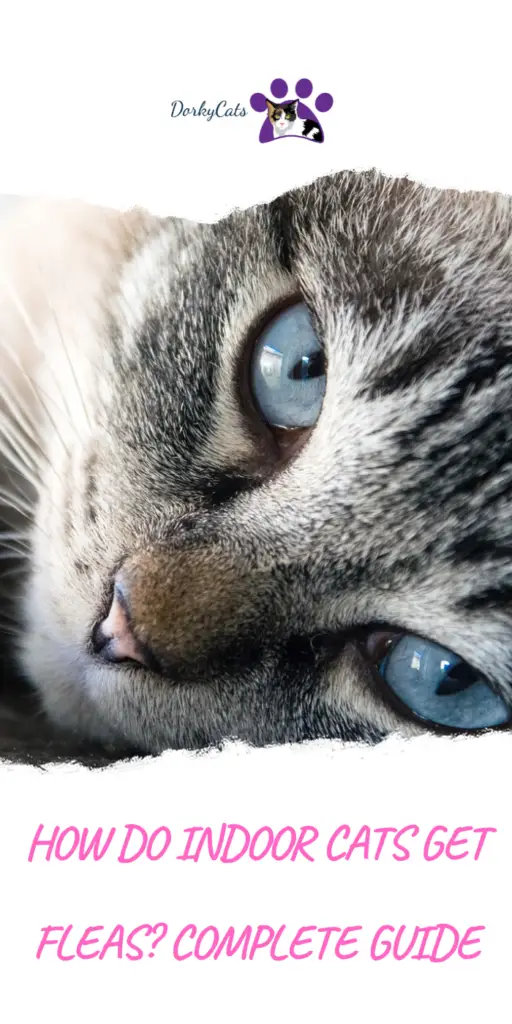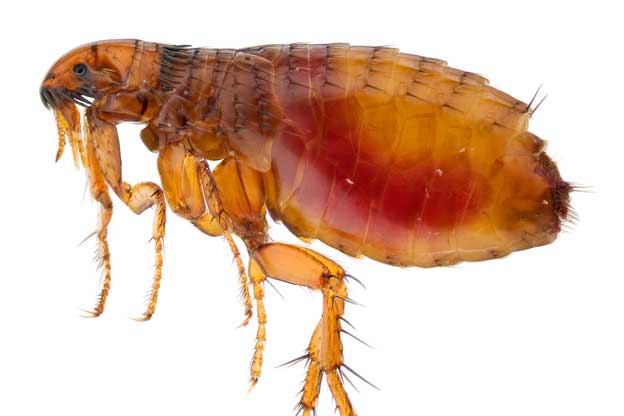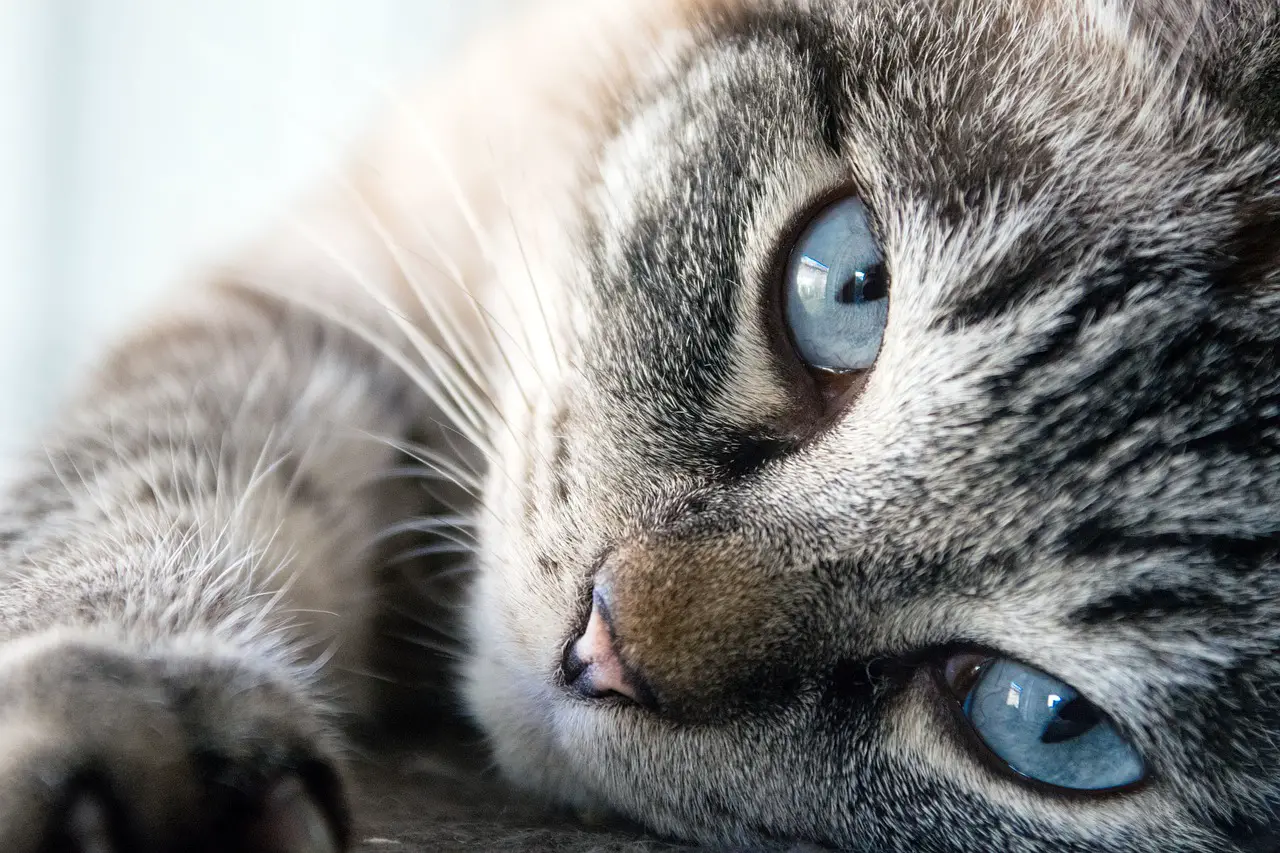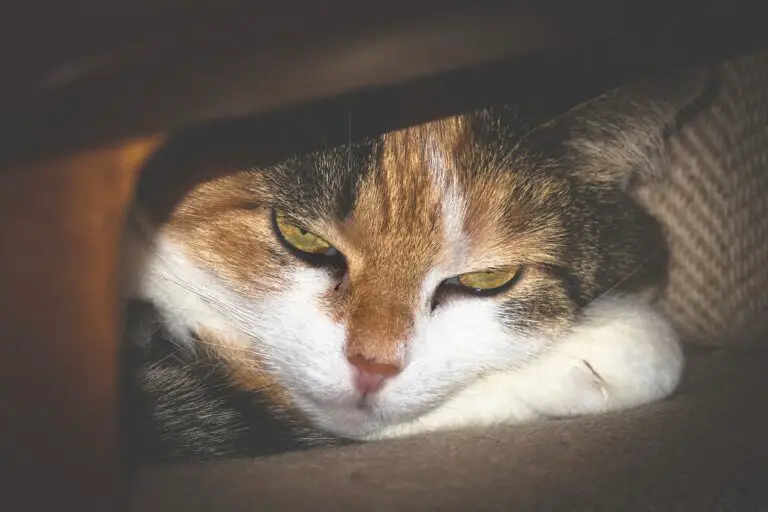HOW DO INDOOR CATS GET FLEAS? COMPLETE GUIDE
How do indoor cats get fleas? While indoor cats have fewer chances to get fleas, they are not entirely out of danger. There are still risks and ways for indoor cats to get fleas. We will go over how it can happen and what can be done about it.
Indoors cats can get fleas when coming in contact with other pets or animals, going shortly outside even on windows, from other humans, visiting the vet or traveling with their owners, changing house and new furniture.
Let’s see in which situation cats can get fleas and what can be done about it.

WHAT ARE FLEAS?
Fleas are insects that leave out of their host blood, making them parasites. They are about 3 millimeters long and brown. Their body is flat and narrow, designed to move through the host fur. Even though they have no wings, their strong legs allow them to jump up to 50 times their length.

They also have strong claws that let them hold tight on their host and have the ability to suck blood through their mouth. As a result, they are common pests and can be brought in by other animals or humans or found in the wild.
Due to their ability to jump, fleas can get into people or pets. Fleas can hide on shoes or clothes and get out when they see a potential host like cats or dogs. The average flea lives for two or three months, but adult fleas can even survive over a year if they find the right host and proper conditions.
WHAT HAPPEN IN CASE OF FLEA BITES ON CATS?
Flea bites can cause a lot of trouble and irritations for cats. They feel itchy and are compelled to scratch themselves. But, itchiness is not the only problem that flea bites can cause to cats. The bit can swell and even cause an allergic reaction.
When cats scratch a flea bite, they can get injured and bleed. Infections can result from it, and they can cause severe problems if not treated. Fleas can bring different types of diseases.
For example, if they are infected, they can bring worms in cats and trigger allergic reactions. Here is a list of problems caused by fleas:
- Tapeworms
- Anemia
- Flea Allergic Dermatitis
- Bartonella
- Typhus
Cats affected by fleas are often scratching themselves, overgrooming, and have sore skins. Fleas can easily be removed and treated in cats, although they are very annoying to deal with.
HOW DO INDOOR CATS GET FLEAS?
Indoors cats can get fleas despite they are protected compared to outdoor cats. Keeping good cleaning habits in the house, grooming cats, and other precautions can reduce the chances of getting fleas. But there is no way to minimize the possibilities down to zero.
Fleas can hide in tiny places and can jump out when they see a good host. They can even jump in the house through an open window or hide under someone’s shoes, and when a guest enters someone’s home, fleas can jump in.
Here are some of the most common ways for fleas to get onto someone’s house and pet:
1. HOUSE GUESTS
Guest can carry fleas in themselves, or fleas could have jumped on them while outside. Unfortunately, guests do not know they have fleas in them, and when they arrive at a house with a pet, they jump on them and start their reproduction work.
Guests with pets (with fleas) entering another house can transmit fleas to the house cat or dog.
2. OPEN DOORS OR WINDOWS
Fleas have strong legs and can jump inside a house through an open window or door. Cats use to stand on windows to look outside or go outside on a porch or balcony. In those instances, fleas can get on cats or enter the house.
Fleas can reach even upper floors because of their ability to jump.
3. CATS GOING OUTSIDE
Outdoor cats have many chances to get fleas, even cats that go out for part of the day. Fleas can hide in many places on the ground or any other animal that a cat can encounter. Therefore, cats going out should have routine protection against fleas.
4. NEW FORNITURE
Fleas can hide on furniture, typically used furniture. Therefore, furniture coming from an environment full of fleas can carry some of them. The same goes for objects, clothes, and any other thing that can hide fleas.
5. VETS VISITS
Cats visiting a vet can get fleas from other pets or fleas hiding somewhere in the office. Vets offices are usually spotless. However, many cats, dogs, and other pets are coming through daily. Some of them can carry fleas that can remain on the premises.
6. TRAVELING
Traveling with cats can be another situation in which cats can be exposed to fleas. Hotels or other premises can be contaminated with fleas, which can jump on cats and be carried back home.
MY INDOOR CAT HAS FLEAS WHAT DO I DO?
Once you have figured out that your cat has fleas, it is time to remedy the situation. Most commonly, the first step is to get rid of fleas on the cat. This can be done with a flea comb and bathing the cat.
Bathing the cat with shampoo and water will kill fleas. There are also many products one can use topically. However, some of those products have to be used carefully, making sure all the instructions are read and applied.
But killing fleas on the cat is only the first step. The rest of the house is to be cleaned to remove any remaining fleas and their eggs. Here are the steps to be done:
- Remove all fleas from a cat with a bath and anti-fleas products
- Wacuum clean often the house, including carpets and all surfaces
- Wash bedding and clothes to remove hidden fleas and eggs
- Steam cleaning is another effective way to remove fleas and their eggs
- Wash cat beddings, and clothes used by the cat
- Use professionals to come and disinfest your house
- Use preventive fleas products
The environment has to be kept cleaned routinely for many weeks, and possibly it is a good idea to bathe and treat your cat a few times every 2 or 4 weeks until the problem is resolved.
FLEA TREATMENT PRODUCTS
Some products can be used to kill fleas and treat a cat that has a fleas problem. Here are some of the best products for flea treatment:












Typically, cat fleas treatments are applied to cats on their neck and base of the skull direct at skin level. The product starts working from the moment of application for several days, killing and repelling fleas. Then, it spreads over the skin and kills fleas on contacts. Some products kill fleas after the insect ingests the product.
If that is the case, the flea has to bite the host to ingest the flea treatment product. So try to find products that can kill fleas on contact.
FREQUENTLY ASKED QUESTIONS
How do you get rid of fleas on indoor cats?
When a cat gets fleas, it is always better to consult a veterinarian to get actionable advice. In addition, there are many fleas prevention products and flea treatment products. Cats should get a bath with the use of shampoo, and the house should be cleaned thoroughly.
Can cats get fleas if they stay indoors?
Yes, cats can get fleas even if they stay indoors. Although the chances are slim, fleas can still find their way into the house through other people or doors and windows.
How can you tell if your cat has fleas?
Cats with fleas are scratching themselves often, can take off chunks of their fur, and can be grooming themselves excessively. Sometimes cats can be annoyed and nervous and even sluggish at times. In some cases, some diseases develop from fleas. In this case, other symptoms can manifest.







